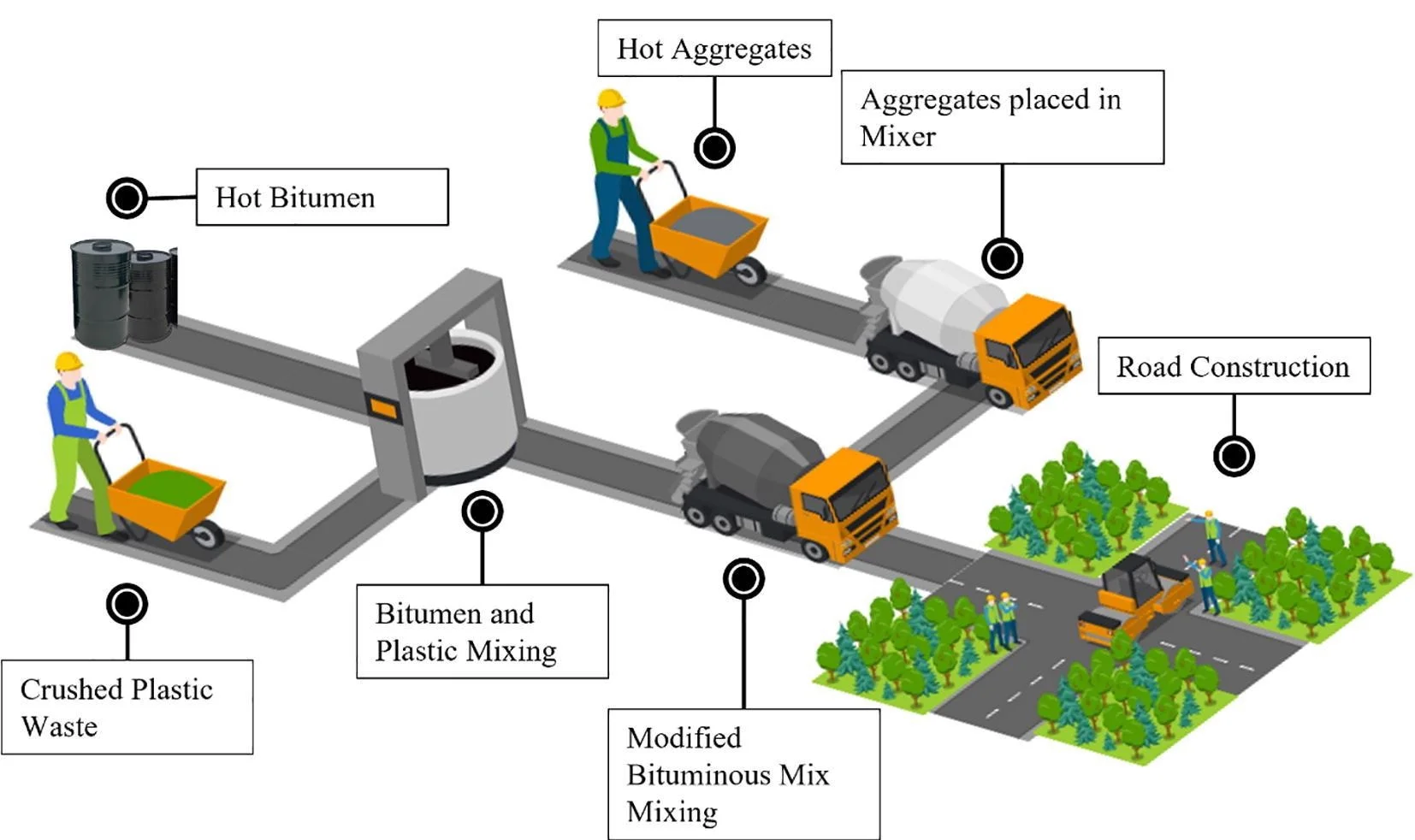Buckle up, folks! We’re taking you on a thrilling adventure through the world of modern road construction. From planning and design to cutting-edge gadgets and eco-friendly practices, we’ll unveil the secrets behind building the smooth streets and highways that make our daily commutes a breeze. Let’s dive into the fascinating details that shape the roads we travel on!
Road Construction Process: From Dirt to Driveway
Ever wonder how that smooth, new stretch of asphalt appears seemingly overnight? It’s not magic, but a carefully choreographed process that transforms raw land into a robust roadway capable of handling everything from compact cars to heavy trucks. Let’s take a behind-the-scenes look at the fascinating world of road construction!
1. The Brainstorming Phase: Planning and Design
Just like you wouldn’t build a house without a blueprint, road construction begins with meticulous planning. Engineers, the architects of our roads, take center stage here. They meticulously map out the road’s path, taking into account crucial factors such as terrain, environmental impact, and future traffic flow. Even drainage is carefully considered to prevent those pesky potholes! Before any earth is moved, a detailed roadmap is created to guide the entire project.
2. Prepping the Stage: Earthwork
This is where the heavy machinery rolls in! Bulldozers and excavators transform the site, clearing vegetation and shaping the earth to match the meticulously crafted blueprint. This foundational work ensures the ground is level, slopes are created for proper drainage, and the earth is compacted to support the immense weight of the road and its future traffic.
3. Building a Strong Foundation: Sub-Base and Base Course
Just like a house needs a solid foundation, a road requires robust underlying layers. First comes the sub-base, often made of crushed stone or gravel, to provide stability and drainage. On top of that goes the base course, a tougher layer, usually asphalt or gravel, engineered to bear the brunt of the traffic load and prevent cracking.
4. The Finishing Touch: Surface Course
This is the part of the road we actually drive on! A smooth, durable layer of asphalt or concrete is carefully applied and compacted using specialized rollers. This surface layer is designed to withstand years of wear and tear from weather and traffic.
5. Putting on the Finishing Touches: Paving and Final Details
The road is almost ready for its debut! The paving team lays down the asphalt or concrete in precise strips, ensuring a smooth and even surface. Once the paving is complete, the finishing touches are added, including lane markings, reflective dots that guide us at night, guardrails for safety, and, of course, the all-important road signs.
Beyond the Basics: The Future of Road Construction
Road construction is constantly evolving. Today, we’re seeing incredible innovations, like using recycled materials to make the process more sustainable and high-tech equipment that can lay down a road with incredible precision. Some roads are even being designed with special surfaces that help reduce noise pollution – how cool is that? As technology advances, we can expect even more exciting developments in the world of road construction, leading to safer, more durable, and environmentally friendly roads for everyone.
What are the Crucial Steps in the Road Construction Process?
We’ve already touched upon the intricate nature of road construction, but let’s dive deeper into the core phases that guarantee a smooth and safe journey for years to come.
1. Blueprints and Preparation: Before any ground is broken, engineers meticulously map out every inch of the road. This blueprint dictates the route, curves, slopes, and even considers how water will naturally drain off to prevent future flooding. Environmental experts are also consulted to minimize the impact on surrounding ecosystems.
2. Laying the Groundwork: Think of this phase as setting the stage for a grand performance. Existing vegetation is cleared, and the earth is sculpted to match the predetermined design. This might involve digging, filling, and compacting the soil to create a rock-solid base. Sometimes, additional materials are mixed in to enhance the soil’s strength and stability.
3. Paving the Way: This is where the road truly starts to take shape. Asphalt or concrete, depending on the project’s needs and budget, is carefully laid down in multiple layers. Temperature plays a crucial role here, as the paving material needs to be at the ideal consistency for proper adhesion and a smooth finish. Heavy rollers then press everything together, ensuring a long-lasting and even surface.
4. The Finishing Touches: While a smooth road is great, it’s the details that make it safe and functional. This final stage involves installing drainage systems to whisk away rainwater, putting up clear traffic signs and signals, and adding lighting for nighttime visibility. Landscaping might also be incorporated to blend the road seamlessly with its surroundings, and decorative elements can add a touch of local character.
Think of it this way: Imagine baking a cake. You wouldn’t just throw all the ingredients together and hope for the best, right? Road construction follows a similar principle. Each step is crucial in creating a final product that is both functional and aesthetically pleasing.
How Does Road Construction Impact the Environment?
We all know that building roads is important – it keeps our traffic flowing and connects us to different places. But let’s face it: all that digging, paving, and building can be tough on the environment. So, what exactly happens when those construction crews get to work?
Our Air Takes a Hit
Think about those big trucks kicking up dust clouds as they move earth around. That dust isn’t just annoying; it’s full of pollutants that can affect the air we breathe. We’re talking about things like nitrogen oxides and carbon monoxide, which contribute to health problems like respiratory issues and even contribute to the bigger problem of climate change.
Water Gets Clouded
Construction sites often have exposed soil, and when it rains (or when they use water for dust control), all that dirt and debris can wash into nearby rivers and streams. This runoff carries sediment that clogs up waterways, making it tough for fish and other aquatic life to thrive. Plus, let’s not forget about the chemicals used in things like asphalt and concrete – those can seep into the water too.
Soil Feels the Pressure
Ever walked on the ground that’s been driven over too many times? It gets hard-packed and difficult for anything to grow. That’s soil compaction, and it’s a big issue on construction sites. Compacted soil makes it hard for plants to take root and can even lead to erosion, where valuable topsoil gets washed away. And of course, when we clear land for roads, we’re often destroying animal habitats in the process.
Can We Build Roads Responsibly?
The good news is that we’re getting smarter about road construction and finding ways to lessen the environmental blow. Here’s how:
Keeping Things Clean:
- Dust Busters: Construction crews are using techniques like spraying water or covering exposed dirt to keep the dust down.
- Erosion Control: Simple things like hay bales and silt fences help prevent soil from washing away during construction.
- Protecting the Wildlife: Building wildlife crossings (think tunnels or bridges) gives animals a safe way to move around without encountering traffic.
Sustainable Solutions:
- Recycling: Instead of using brand new materials, we can crush up old concrete and asphalt to use in new roads, saving resources and reducing waste.
- Energy Efficiency: Think energy-efficient streetlights and drainage systems that reduce our overall environmental footprint.
- Smarter Designs: Engineers are designing roads to minimize runoff and pollution.
By taking these steps, we can have roads that are less harmful to the environment. It’s all about finding a balance between our need for transportation and protecting the planet.
Exploring the Latest Road Construction Techniques and Technologies
Building roads today is a whole different ball game than it used to be. It’s not just about laying down pavement anymore. We’re talking high-tech planning, innovative designs, and using cutting-edge technology to make sure our roads are built to last, stay safe, and even look out for the environment.
Think about it: our roads have to handle tons of traffic, deal with all kinds of weather, and stay in good shape for years to come. That’s where these new techniques and technologies come into play.
Building Smarter Roads
One of the coolest things happening in road construction is the use of “smart” materials. Take porous asphalt, for example. This stuff acts like a giant sponge, soaking up rainwater instead of letting it run off and cause flooding. Not only does this help the environment, but it also reduces the risk of those dangerous puddles and skids on the road.
And speaking of safety, have you heard of glow-in-the-dark roads? These futuristic roads are embedded with special materials that absorb sunlight during the day and then emit a soft glow at night, making it easier for drivers to see the way even when it’s pitch black. It’s like something out of a sci-fi movie, but it’s happening right here, right now.
Eco-Friendly Construction
Another big focus in modern road building is sustainability. We’re all becoming more aware of our impact on the planet, and construction companies are no exception. That’s why they’re turning to things like recycled materials, using crushed concrete and old asphalt to create new road surfaces. It’s a win-win: less waste in landfills and less need to extract new resources.
Even the way we build roads is changing. Autonomous construction equipment and drones are becoming more common on job sites, and it’s not just about looking cool (though that’s a bonus). These high-tech helpers can work with incredible precision, reducing waste and making the construction process faster and safer for everyone involved.
The Benefits Add Up
So, what’s the big deal with all these fancy new techniques? Well, for starters, they save money. Sustainable practices and durable materials mean fewer repairs and less maintenance down the line. And safer roads mean fewer accidents, which is good news for everyone.
Here’s a breakdown of the benefits:
| Benefit | Description |
|---|---|
| Cost Savings | By using recycled materials and making roads that last longer, we spend less money fixing them up all the time. |
| Improved Safety | Features like glow-in-the-dark markings and smart traffic systems help prevent accidents and keep drivers safe. |
| Sustainability | From using recycled materials to reducing emissions, road construction is becoming more environmentally friendly. |
| Durability | New materials and techniques are making roads tougher, so they can handle heavy traffic and harsh weather conditions for years to come. |
The Road Ahead
It’s clear that road construction is on the brink of a technological revolution. As we develop even more innovative techniques and technologies, we can look forward to safer, more sustainable, and more efficient roads that connect us all.
- Backsplash For Gray Cabinets: Choosing the Right Backsplash Style - December 13, 2025
- Gray And White Backsplash: Ideas For Timeless Style - December 12, 2025
- Gray Kitchen Backsplash Ideas: Find Your Perfect Gray Tile - December 11, 2025









